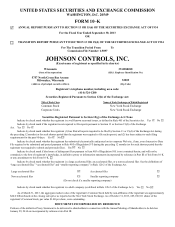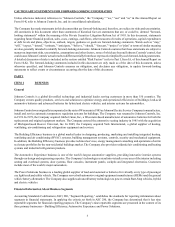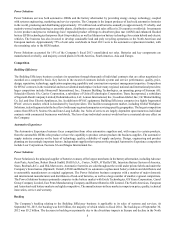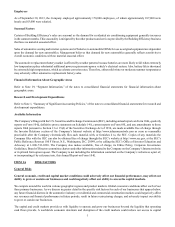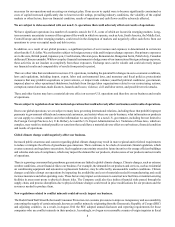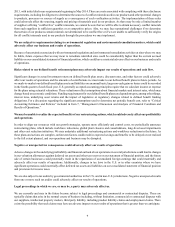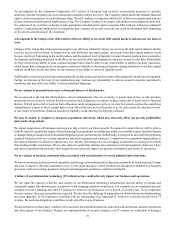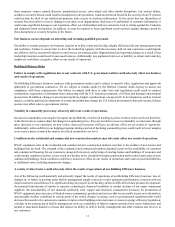Johnson Controls 2013 Annual Report Download - page 9
Download and view the complete annual report
Please find page 9 of the 2013 Johnson Controls annual report below. You can navigate through the pages in the report by either clicking on the pages listed below, or by using the keyword search tool below to find specific information within the annual report.9
2013, with initial disclosure requirements beginning in May 2014. There are costs associated with complying with these disclosure
requirements, including for diligence to determine the sources of conflict minerals used in our products and other potential changes
to products, processes or sources of supply as a consequence of such verification activities. The implementation of these rules
could adversely affect the sourcing, supply and pricing of materials used in our products. As there may be only a limited number
of suppliers offering “conflict free” conflict minerals, we cannot be sure that we will be able to obtain necessary conflict minerals
from such suppliers in sufficient quantities or at competitive prices. Also, we may face reputational challenges if we determine
that certain of our products contain minerals not determined to be conflict free or if we are unable to sufficiently verify the origins
for all conflict minerals used in our products through the procedures we may implement.
We are subject to requirements relating to environmental regulation and environmental remediation matters, which could
adversely affect our business and results of operations.
Because of uncertainties associated with environmental regulation and environmental remediation activities at sites where we may
be liable, future expenses that we may incur to remediate identified sites could be considerably higher than the current accrued
liability on our consolidated statement of financial position, which could have a material adverse effect on our business and results
of operations.
Risks related to our defined benefit retirement plans may adversely impact our results of operations and cash flow.
Significant changes in actual investment return on defined benefit plan assets, discount rates, and other factors could adversely
affect our results of operations and the amounts of contributions we must make to our defined benefit plans in future periods. As
we mark-to-market our defined benefit plan assets and liabilities on an annual basis, large non-cash gains or losses could be recorded
in the fourth quarter of each fiscal year. U.S. generally accepted accounting principles require that we calculate income or expense
for the plans using actuarial valuations. These valuations reflect assumptions about financial markets and interest rates, which may
change based on economic conditions. Funding requirements for our defined benefit plans are dependent upon, among other things,
interest rates, underlying asset returns and the impact of legislative or regulatory changes related to defined benefit funding
obligations. For a discussion regarding the significant assumptions used to determine net periodic benefit cost, refer to “Critical
Accounting Estimates and Policies” included in Item 7, “Management’s Discussion and Analysis of Financial Condition and
Results of Operations.”
We may be unable to realize the expected benefits of our restructuring actions, which could adversely affect our profitability
and operations.
In order to align our resources with our growth strategies, operate more efficiently and control costs, we periodically announce
restructuring plans, which include workforce reductions, global plant closures and consolidations, long-lived asset impairments
and other cost reduction initiatives. We may undertake additional restructuring actions and workforce reductions in the future. As
these plans and actions are complex, unforeseen factors could result in expected savings and benefits to be delayed or not realized
to the full extent planned, and our operations and business may be disrupted.
Negative or unexpected tax consequences could adversely affect our results of operations.
Adverse changes in the underlying profitability and financial outlook of our operations in several jurisdictions could lead to changes
in our valuation allowances against deferred tax assets and other tax reserves on our statement of financial position, and the future
sale of certain businesses could potentially result in the repatriation of accumulated foreign earnings that could materially and
adversely affect our results of operations. Additionally, changes in tax laws in the U.S. or in other countries where we have
significant operations could materially affect deferred tax assets and liabilities on our consolidated statement of financial position
and provision for income taxes.
We are also subject to tax audits by governmental authorities in the U.S. and in non-U.S. jurisdictions. Negative unexpected results
from one or more such tax audits could adversely affect our results of operations.
Legal proceedings in which we are, or may be, a party may adversely affect us.
We are currently and may in the future become subject to legal proceedings and commercial or contractual disputes. These are
typically claims that arise in the normal course of business including, without limitation, commercial or contractual disputes with
our suppliers, intellectual property matters, third party liability, including product liability claims and employment claims. There
exists the possibility that such claims may have an adverse impact on our results of operations that is greater than we anticipate.

